Sepsis Management and Antibiotic Dosing
VerifiedAdded on 2020/01/23
|11
|3197
|158
Literature Review
AI Summary
This assignment focuses on the critical aspects of managing severe sepsis and septic shock, particularly emphasizing appropriate antibiotic dosing in patients with acute renal failure. It delves into various treatment strategies, including fluid resuscitation, steroid therapy, and the choice between monotherapy and combination antibiotics. The discussion draws upon relevant research articles, guidelines from organizations like the Surviving Sepsis Campaign, and clinical evidence to provide a comprehensive understanding of sepsis management.
Contribute Materials
Your contribution can guide someone’s learning journey. Share your
documents today.

LITERATURE REVIEW
Secure Best Marks with AI Grader
Need help grading? Try our AI Grader for instant feedback on your assignments.

Table of Contents
INTRODUCTION................................................................................................................................3
LITERATURE REVIEW ....................................................................................................................3
CONCLUSION....................................................................................................................................8
REFERENCES.....................................................................................................................................9
INTRODUCTION................................................................................................................................3
LITERATURE REVIEW ....................................................................................................................3
CONCLUSION....................................................................................................................................8
REFERENCES.....................................................................................................................................9
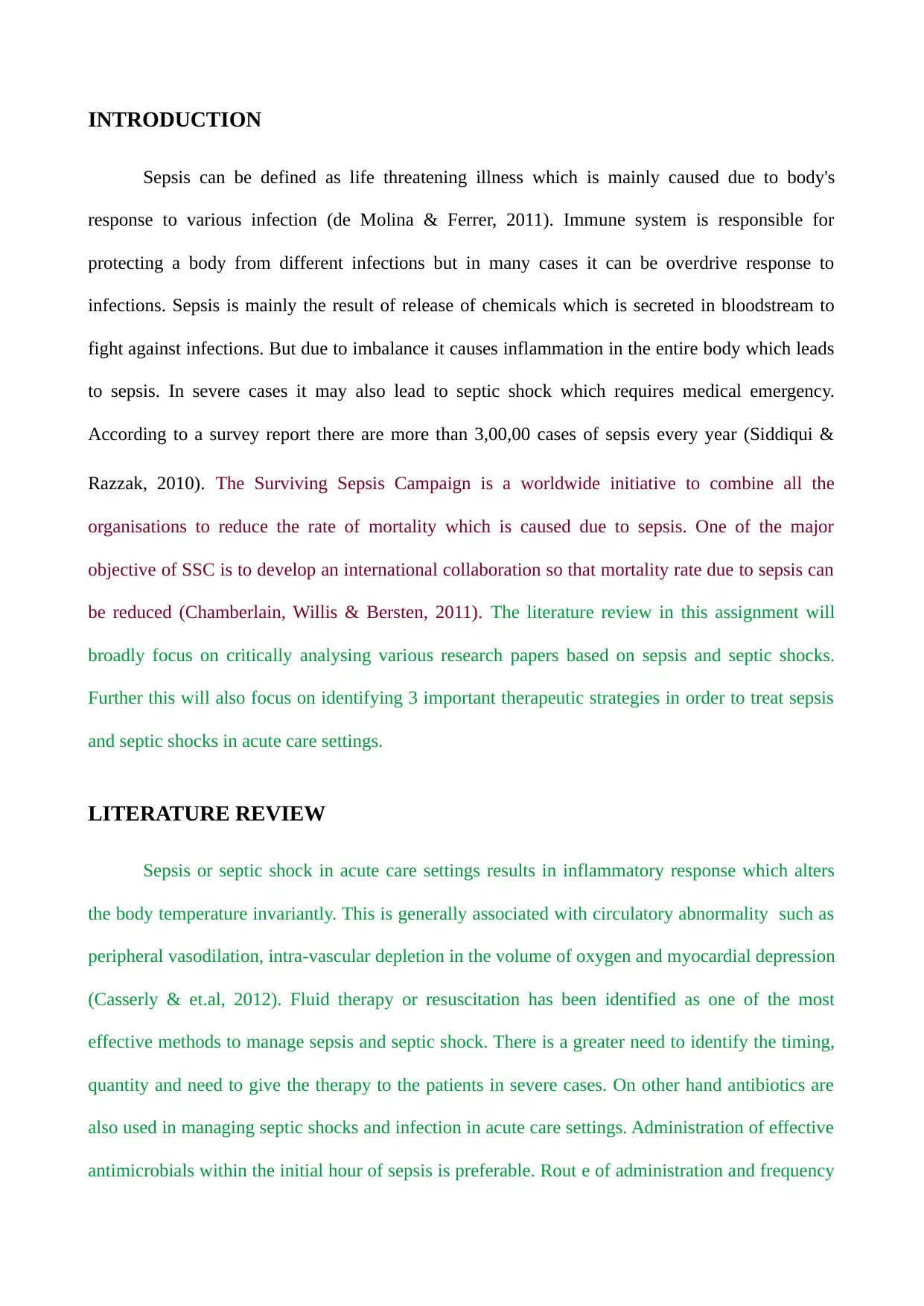
INTRODUCTION
Sepsis can be defined as life threatening illness which is mainly caused due to body's
response to various infection (de Molina & Ferrer, 2011). Immune system is responsible for
protecting a body from different infections but in many cases it can be overdrive response to
infections. Sepsis is mainly the result of release of chemicals which is secreted in bloodstream to
fight against infections. But due to imbalance it causes inflammation in the entire body which leads
to sepsis. In severe cases it may also lead to septic shock which requires medical emergency.
According to a survey report there are more than 3,00,00 cases of sepsis every year (Siddiqui &
Razzak, 2010). The Surviving Sepsis Campaign is a worldwide initiative to combine all the
organisations to reduce the rate of mortality which is caused due to sepsis. One of the major
objective of SSC is to develop an international collaboration so that mortality rate due to sepsis can
be reduced (Chamberlain, Willis & Bersten, 2011). The literature review in this assignment will
broadly focus on critically analysing various research papers based on sepsis and septic shocks.
Further this will also focus on identifying 3 important therapeutic strategies in order to treat sepsis
and septic shocks in acute care settings.
LITERATURE REVIEW
Sepsis or septic shock in acute care settings results in inflammatory response which alters
the body temperature invariantly. This is generally associated with circulatory abnormality such as
peripheral vasodilation, intra-vascular depletion in the volume of oxygen and myocardial depression
(Casserly & et.al, 2012). Fluid therapy or resuscitation has been identified as one of the most
effective methods to manage sepsis and septic shock. There is a greater need to identify the timing,
quantity and need to give the therapy to the patients in severe cases. On other hand antibiotics are
also used in managing septic shocks and infection in acute care settings. Administration of effective
antimicrobials within the initial hour of sepsis is preferable. Rout e of administration and frequency
Sepsis can be defined as life threatening illness which is mainly caused due to body's
response to various infection (de Molina & Ferrer, 2011). Immune system is responsible for
protecting a body from different infections but in many cases it can be overdrive response to
infections. Sepsis is mainly the result of release of chemicals which is secreted in bloodstream to
fight against infections. But due to imbalance it causes inflammation in the entire body which leads
to sepsis. In severe cases it may also lead to septic shock which requires medical emergency.
According to a survey report there are more than 3,00,00 cases of sepsis every year (Siddiqui &
Razzak, 2010). The Surviving Sepsis Campaign is a worldwide initiative to combine all the
organisations to reduce the rate of mortality which is caused due to sepsis. One of the major
objective of SSC is to develop an international collaboration so that mortality rate due to sepsis can
be reduced (Chamberlain, Willis & Bersten, 2011). The literature review in this assignment will
broadly focus on critically analysing various research papers based on sepsis and septic shocks.
Further this will also focus on identifying 3 important therapeutic strategies in order to treat sepsis
and septic shocks in acute care settings.
LITERATURE REVIEW
Sepsis or septic shock in acute care settings results in inflammatory response which alters
the body temperature invariantly. This is generally associated with circulatory abnormality such as
peripheral vasodilation, intra-vascular depletion in the volume of oxygen and myocardial depression
(Casserly & et.al, 2012). Fluid therapy or resuscitation has been identified as one of the most
effective methods to manage sepsis and septic shock. There is a greater need to identify the timing,
quantity and need to give the therapy to the patients in severe cases. On other hand antibiotics are
also used in managing septic shocks and infection in acute care settings. Administration of effective
antimicrobials within the initial hour of sepsis is preferable. Rout e of administration and frequency
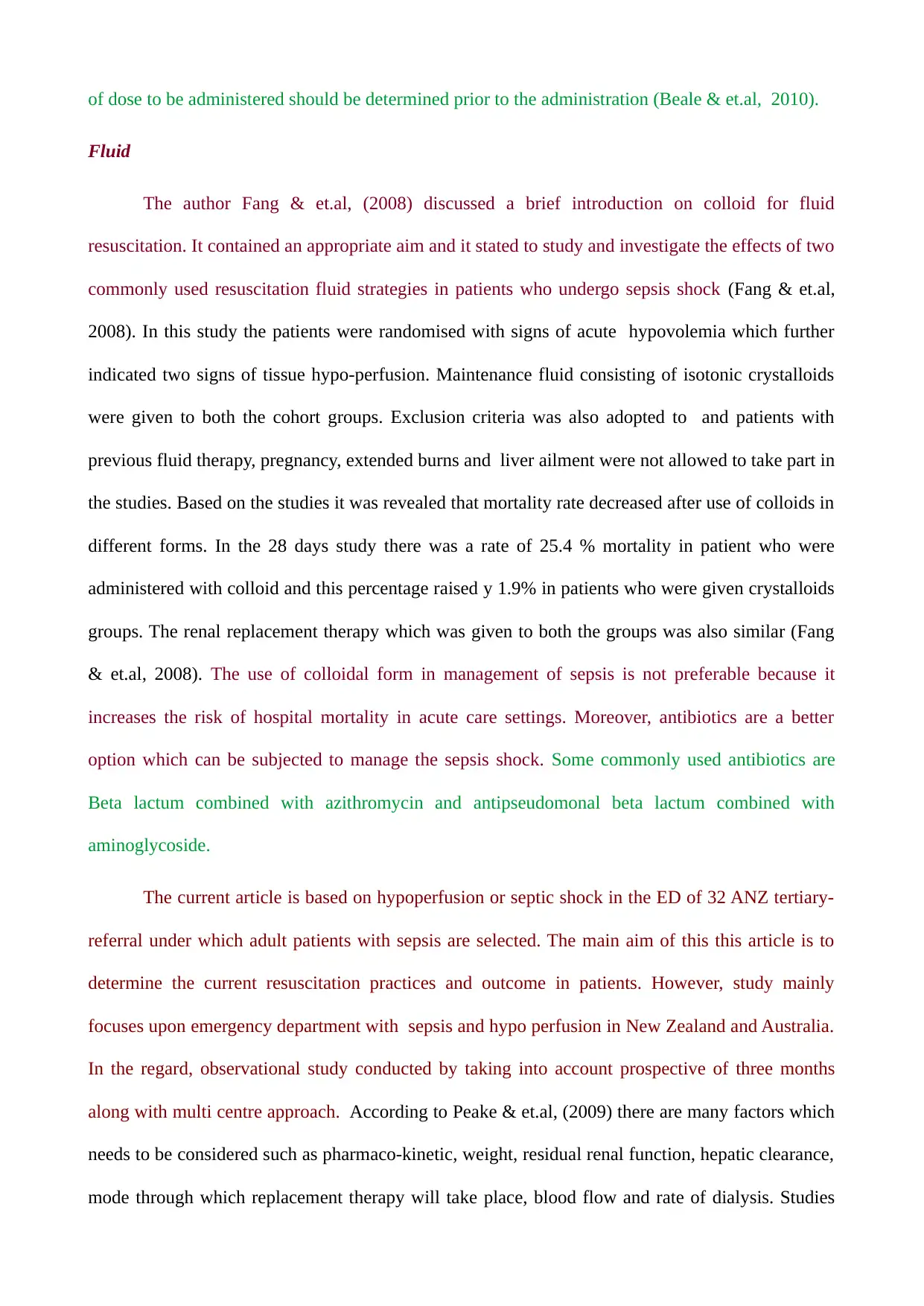
of dose to be administered should be determined prior to the administration (Beale & et.al, 2010).
Fluid
The author Fang & et.al, (2008) discussed a brief introduction on colloid for fluid
resuscitation. It contained an appropriate aim and it stated to study and investigate the effects of two
commonly used resuscitation fluid strategies in patients who undergo sepsis shock (Fang & et.al,
2008). In this study the patients were randomised with signs of acute hypovolemia which further
indicated two signs of tissue hypo-perfusion. Maintenance fluid consisting of isotonic crystalloids
were given to both the cohort groups. Exclusion criteria was also adopted to and patients with
previous fluid therapy, pregnancy, extended burns and liver ailment were not allowed to take part in
the studies. Based on the studies it was revealed that mortality rate decreased after use of colloids in
different forms. In the 28 days study there was a rate of 25.4 % mortality in patient who were
administered with colloid and this percentage raised y 1.9% in patients who were given crystalloids
groups. The renal replacement therapy which was given to both the groups was also similar (Fang
& et.al, 2008). The use of colloidal form in management of sepsis is not preferable because it
increases the risk of hospital mortality in acute care settings. Moreover, antibiotics are a better
option which can be subjected to manage the sepsis shock. Some commonly used antibiotics are
Beta lactum combined with azithromycin and antipseudomonal beta lactum combined with
aminoglycoside.
The current article is based on hypoperfusion or septic shock in the ED of 32 ANZ tertiary-
referral under which adult patients with sepsis are selected. The main aim of this this article is to
determine the current resuscitation practices and outcome in patients. However, study mainly
focuses upon emergency department with sepsis and hypo perfusion in New Zealand and Australia.
In the regard, observational study conducted by taking into account prospective of three months
along with multi centre approach. According to Peake & et.al, (2009) there are many factors which
needs to be considered such as pharmaco-kinetic, weight, residual renal function, hepatic clearance,
mode through which replacement therapy will take place, blood flow and rate of dialysis. Studies
Fluid
The author Fang & et.al, (2008) discussed a brief introduction on colloid for fluid
resuscitation. It contained an appropriate aim and it stated to study and investigate the effects of two
commonly used resuscitation fluid strategies in patients who undergo sepsis shock (Fang & et.al,
2008). In this study the patients were randomised with signs of acute hypovolemia which further
indicated two signs of tissue hypo-perfusion. Maintenance fluid consisting of isotonic crystalloids
were given to both the cohort groups. Exclusion criteria was also adopted to and patients with
previous fluid therapy, pregnancy, extended burns and liver ailment were not allowed to take part in
the studies. Based on the studies it was revealed that mortality rate decreased after use of colloids in
different forms. In the 28 days study there was a rate of 25.4 % mortality in patient who were
administered with colloid and this percentage raised y 1.9% in patients who were given crystalloids
groups. The renal replacement therapy which was given to both the groups was also similar (Fang
& et.al, 2008). The use of colloidal form in management of sepsis is not preferable because it
increases the risk of hospital mortality in acute care settings. Moreover, antibiotics are a better
option which can be subjected to manage the sepsis shock. Some commonly used antibiotics are
Beta lactum combined with azithromycin and antipseudomonal beta lactum combined with
aminoglycoside.
The current article is based on hypoperfusion or septic shock in the ED of 32 ANZ tertiary-
referral under which adult patients with sepsis are selected. The main aim of this this article is to
determine the current resuscitation practices and outcome in patients. However, study mainly
focuses upon emergency department with sepsis and hypo perfusion in New Zealand and Australia.
In the regard, observational study conducted by taking into account prospective of three months
along with multi centre approach. According to Peake & et.al, (2009) there are many factors which
needs to be considered such as pharmaco-kinetic, weight, residual renal function, hepatic clearance,
mode through which replacement therapy will take place, blood flow and rate of dialysis. Studies
Secure Best Marks with AI Grader
Need help grading? Try our AI Grader for instant feedback on your assignments.
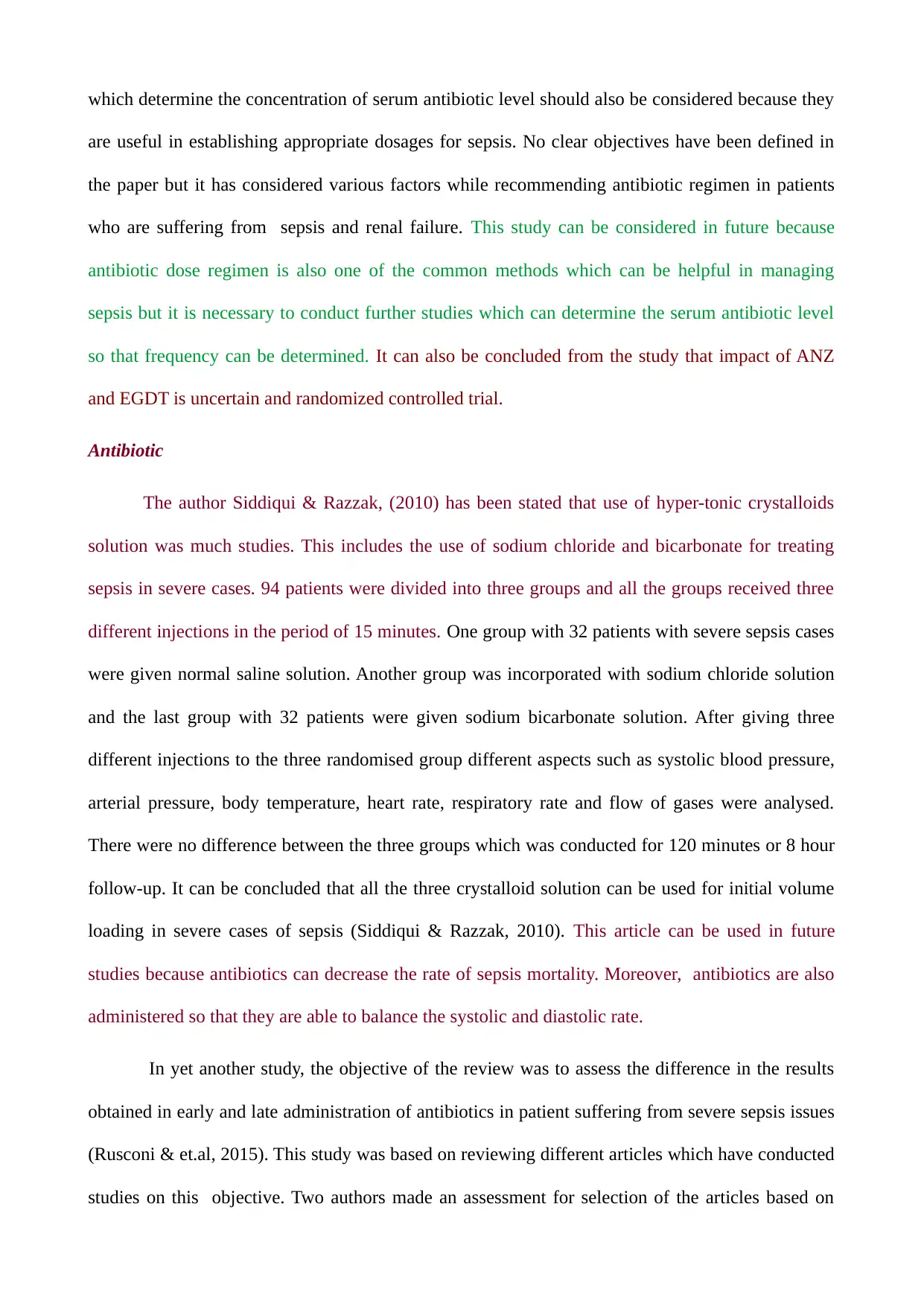
which determine the concentration of serum antibiotic level should also be considered because they
are useful in establishing appropriate dosages for sepsis. No clear objectives have been defined in
the paper but it has considered various factors while recommending antibiotic regimen in patients
who are suffering from sepsis and renal failure. This study can be considered in future because
antibiotic dose regimen is also one of the common methods which can be helpful in managing
sepsis but it is necessary to conduct further studies which can determine the serum antibiotic level
so that frequency can be determined. It can also be concluded from the study that impact of ANZ
and EGDT is uncertain and randomized controlled trial.
Antibiotic
The author Siddiqui & Razzak, (2010) has been stated that use of hyper-tonic crystalloids
solution was much studies. This includes the use of sodium chloride and bicarbonate for treating
sepsis in severe cases. 94 patients were divided into three groups and all the groups received three
different injections in the period of 15 minutes. One group with 32 patients with severe sepsis cases
were given normal saline solution. Another group was incorporated with sodium chloride solution
and the last group with 32 patients were given sodium bicarbonate solution. After giving three
different injections to the three randomised group different aspects such as systolic blood pressure,
arterial pressure, body temperature, heart rate, respiratory rate and flow of gases were analysed.
There were no difference between the three groups which was conducted for 120 minutes or 8 hour
follow-up. It can be concluded that all the three crystalloid solution can be used for initial volume
loading in severe cases of sepsis (Siddiqui & Razzak, 2010). This article can be used in future
studies because antibiotics can decrease the rate of sepsis mortality. Moreover, antibiotics are also
administered so that they are able to balance the systolic and diastolic rate.
In yet another study, the objective of the review was to assess the difference in the results
obtained in early and late administration of antibiotics in patient suffering from severe sepsis issues
(Rusconi & et.al, 2015). This study was based on reviewing different articles which have conducted
studies on this objective. Two authors made an assessment for selection of the articles based on
are useful in establishing appropriate dosages for sepsis. No clear objectives have been defined in
the paper but it has considered various factors while recommending antibiotic regimen in patients
who are suffering from sepsis and renal failure. This study can be considered in future because
antibiotic dose regimen is also one of the common methods which can be helpful in managing
sepsis but it is necessary to conduct further studies which can determine the serum antibiotic level
so that frequency can be determined. It can also be concluded from the study that impact of ANZ
and EGDT is uncertain and randomized controlled trial.
Antibiotic
The author Siddiqui & Razzak, (2010) has been stated that use of hyper-tonic crystalloids
solution was much studies. This includes the use of sodium chloride and bicarbonate for treating
sepsis in severe cases. 94 patients were divided into three groups and all the groups received three
different injections in the period of 15 minutes. One group with 32 patients with severe sepsis cases
were given normal saline solution. Another group was incorporated with sodium chloride solution
and the last group with 32 patients were given sodium bicarbonate solution. After giving three
different injections to the three randomised group different aspects such as systolic blood pressure,
arterial pressure, body temperature, heart rate, respiratory rate and flow of gases were analysed.
There were no difference between the three groups which was conducted for 120 minutes or 8 hour
follow-up. It can be concluded that all the three crystalloid solution can be used for initial volume
loading in severe cases of sepsis (Siddiqui & Razzak, 2010). This article can be used in future
studies because antibiotics can decrease the rate of sepsis mortality. Moreover, antibiotics are also
administered so that they are able to balance the systolic and diastolic rate.
In yet another study, the objective of the review was to assess the difference in the results
obtained in early and late administration of antibiotics in patient suffering from severe sepsis issues
(Rusconi & et.al, 2015). This study was based on reviewing different articles which have conducted
studies on this objective. Two authors made an assessment for selection of the articles based on
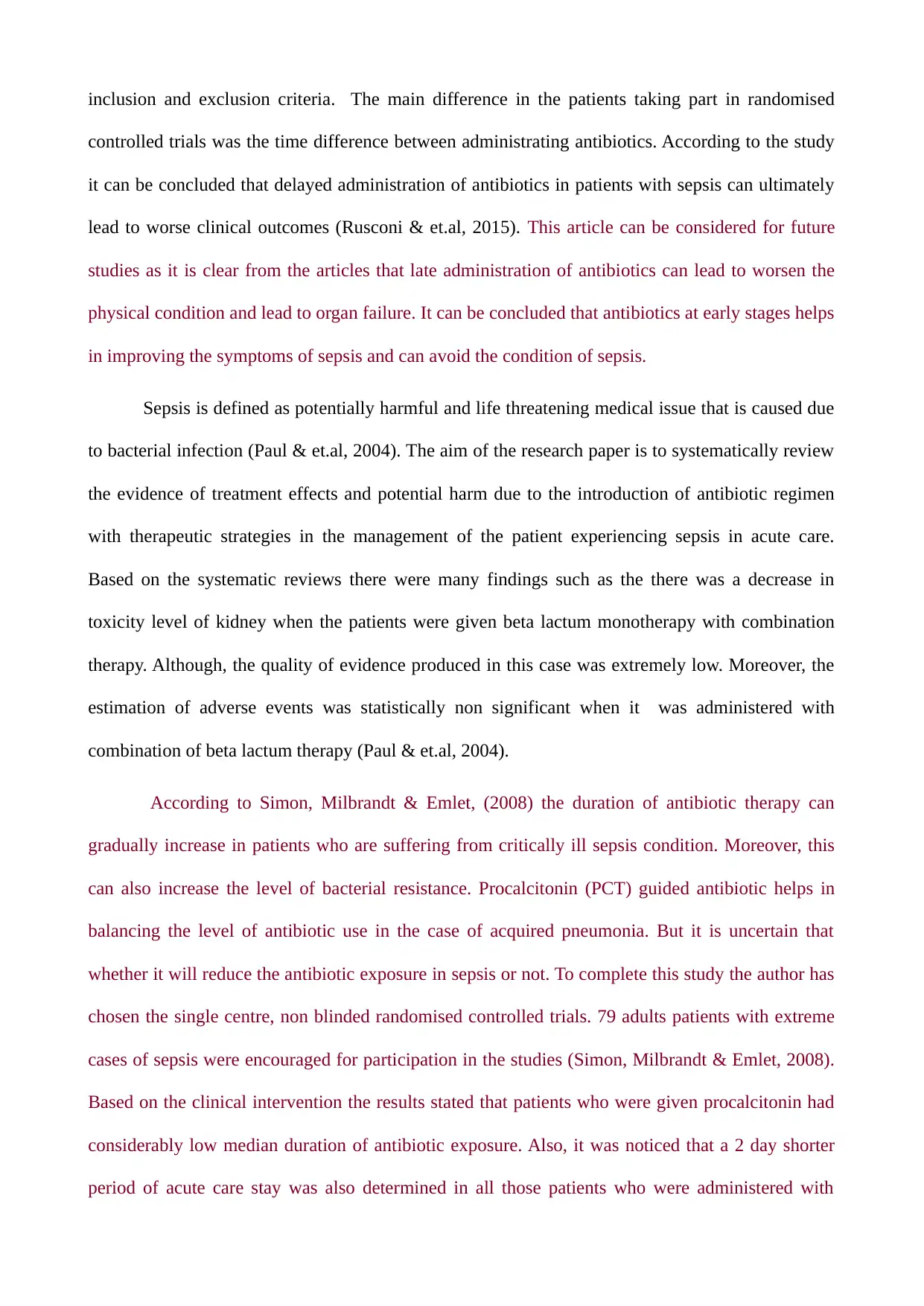
inclusion and exclusion criteria. The main difference in the patients taking part in randomised
controlled trials was the time difference between administrating antibiotics. According to the study
it can be concluded that delayed administration of antibiotics in patients with sepsis can ultimately
lead to worse clinical outcomes (Rusconi & et.al, 2015). This article can be considered for future
studies as it is clear from the articles that late administration of antibiotics can lead to worsen the
physical condition and lead to organ failure. It can be concluded that antibiotics at early stages helps
in improving the symptoms of sepsis and can avoid the condition of sepsis.
Sepsis is defined as potentially harmful and life threatening medical issue that is caused due
to bacterial infection (Paul & et.al, 2004). The aim of the research paper is to systematically review
the evidence of treatment effects and potential harm due to the introduction of antibiotic regimen
with therapeutic strategies in the management of the patient experiencing sepsis in acute care.
Based on the systematic reviews there were many findings such as the there was a decrease in
toxicity level of kidney when the patients were given beta lactum monotherapy with combination
therapy. Although, the quality of evidence produced in this case was extremely low. Moreover, the
estimation of adverse events was statistically non significant when it was administered with
combination of beta lactum therapy (Paul & et.al, 2004).
According to Simon, Milbrandt & Emlet, (2008) the duration of antibiotic therapy can
gradually increase in patients who are suffering from critically ill sepsis condition. Moreover, this
can also increase the level of bacterial resistance. Procalcitonin (PCT) guided antibiotic helps in
balancing the level of antibiotic use in the case of acquired pneumonia. But it is uncertain that
whether it will reduce the antibiotic exposure in sepsis or not. To complete this study the author has
chosen the single centre, non blinded randomised controlled trials. 79 adults patients with extreme
cases of sepsis were encouraged for participation in the studies (Simon, Milbrandt & Emlet, 2008).
Based on the clinical intervention the results stated that patients who were given procalcitonin had
considerably low median duration of antibiotic exposure. Also, it was noticed that a 2 day shorter
period of acute care stay was also determined in all those patients who were administered with
controlled trials was the time difference between administrating antibiotics. According to the study
it can be concluded that delayed administration of antibiotics in patients with sepsis can ultimately
lead to worse clinical outcomes (Rusconi & et.al, 2015). This article can be considered for future
studies as it is clear from the articles that late administration of antibiotics can lead to worsen the
physical condition and lead to organ failure. It can be concluded that antibiotics at early stages helps
in improving the symptoms of sepsis and can avoid the condition of sepsis.
Sepsis is defined as potentially harmful and life threatening medical issue that is caused due
to bacterial infection (Paul & et.al, 2004). The aim of the research paper is to systematically review
the evidence of treatment effects and potential harm due to the introduction of antibiotic regimen
with therapeutic strategies in the management of the patient experiencing sepsis in acute care.
Based on the systematic reviews there were many findings such as the there was a decrease in
toxicity level of kidney when the patients were given beta lactum monotherapy with combination
therapy. Although, the quality of evidence produced in this case was extremely low. Moreover, the
estimation of adverse events was statistically non significant when it was administered with
combination of beta lactum therapy (Paul & et.al, 2004).
According to Simon, Milbrandt & Emlet, (2008) the duration of antibiotic therapy can
gradually increase in patients who are suffering from critically ill sepsis condition. Moreover, this
can also increase the level of bacterial resistance. Procalcitonin (PCT) guided antibiotic helps in
balancing the level of antibiotic use in the case of acquired pneumonia. But it is uncertain that
whether it will reduce the antibiotic exposure in sepsis or not. To complete this study the author has
chosen the single centre, non blinded randomised controlled trials. 79 adults patients with extreme
cases of sepsis were encouraged for participation in the studies (Simon, Milbrandt & Emlet, 2008).
Based on the clinical intervention the results stated that patients who were given procalcitonin had
considerably low median duration of antibiotic exposure. Also, it was noticed that a 2 day shorter
period of acute care stay was also determined in all those patients who were administered with
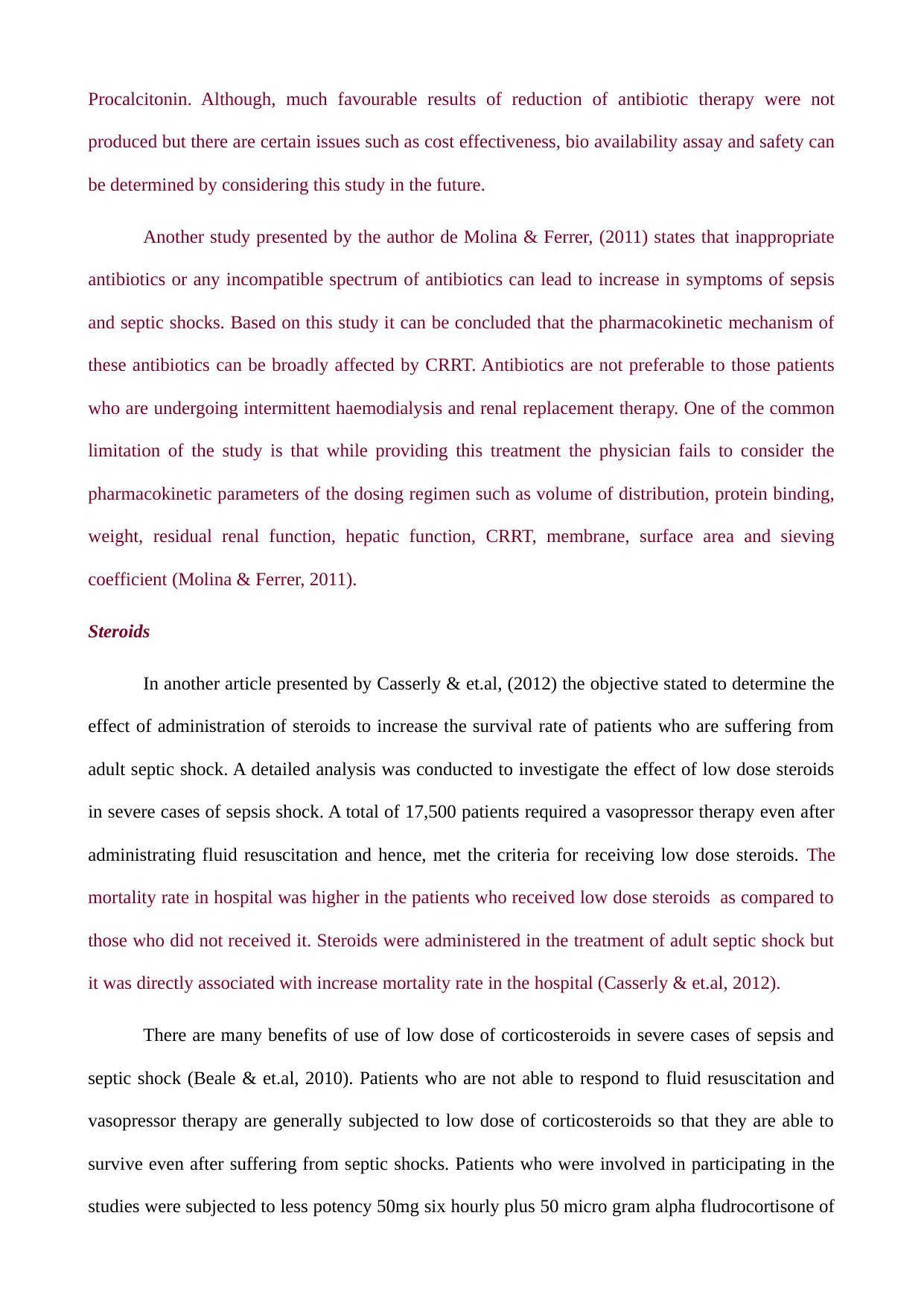
Procalcitonin. Although, much favourable results of reduction of antibiotic therapy were not
produced but there are certain issues such as cost effectiveness, bio availability assay and safety can
be determined by considering this study in the future.
Another study presented by the author de Molina & Ferrer, (2011) states that inappropriate
antibiotics or any incompatible spectrum of antibiotics can lead to increase in symptoms of sepsis
and septic shocks. Based on this study it can be concluded that the pharmacokinetic mechanism of
these antibiotics can be broadly affected by CRRT. Antibiotics are not preferable to those patients
who are undergoing intermittent haemodialysis and renal replacement therapy. One of the common
limitation of the study is that while providing this treatment the physician fails to consider the
pharmacokinetic parameters of the dosing regimen such as volume of distribution, protein binding,
weight, residual renal function, hepatic function, CRRT, membrane, surface area and sieving
coefficient (Molina & Ferrer, 2011).
Steroids
In another article presented by Casserly & et.al, (2012) the objective stated to determine the
effect of administration of steroids to increase the survival rate of patients who are suffering from
adult septic shock. A detailed analysis was conducted to investigate the effect of low dose steroids
in severe cases of sepsis shock. A total of 17,500 patients required a vasopressor therapy even after
administrating fluid resuscitation and hence, met the criteria for receiving low dose steroids. The
mortality rate in hospital was higher in the patients who received low dose steroids as compared to
those who did not received it. Steroids were administered in the treatment of adult septic shock but
it was directly associated with increase mortality rate in the hospital (Casserly & et.al, 2012).
There are many benefits of use of low dose of corticosteroids in severe cases of sepsis and
septic shock (Beale & et.al, 2010). Patients who are not able to respond to fluid resuscitation and
vasopressor therapy are generally subjected to low dose of corticosteroids so that they are able to
survive even after suffering from septic shocks. Patients who were involved in participating in the
studies were subjected to less potency 50mg six hourly plus 50 micro gram alpha fludrocortisone of
produced but there are certain issues such as cost effectiveness, bio availability assay and safety can
be determined by considering this study in the future.
Another study presented by the author de Molina & Ferrer, (2011) states that inappropriate
antibiotics or any incompatible spectrum of antibiotics can lead to increase in symptoms of sepsis
and septic shocks. Based on this study it can be concluded that the pharmacokinetic mechanism of
these antibiotics can be broadly affected by CRRT. Antibiotics are not preferable to those patients
who are undergoing intermittent haemodialysis and renal replacement therapy. One of the common
limitation of the study is that while providing this treatment the physician fails to consider the
pharmacokinetic parameters of the dosing regimen such as volume of distribution, protein binding,
weight, residual renal function, hepatic function, CRRT, membrane, surface area and sieving
coefficient (Molina & Ferrer, 2011).
Steroids
In another article presented by Casserly & et.al, (2012) the objective stated to determine the
effect of administration of steroids to increase the survival rate of patients who are suffering from
adult septic shock. A detailed analysis was conducted to investigate the effect of low dose steroids
in severe cases of sepsis shock. A total of 17,500 patients required a vasopressor therapy even after
administrating fluid resuscitation and hence, met the criteria for receiving low dose steroids. The
mortality rate in hospital was higher in the patients who received low dose steroids as compared to
those who did not received it. Steroids were administered in the treatment of adult septic shock but
it was directly associated with increase mortality rate in the hospital (Casserly & et.al, 2012).
There are many benefits of use of low dose of corticosteroids in severe cases of sepsis and
septic shock (Beale & et.al, 2010). Patients who are not able to respond to fluid resuscitation and
vasopressor therapy are generally subjected to low dose of corticosteroids so that they are able to
survive even after suffering from septic shocks. Patients who were involved in participating in the
studies were subjected to less potency 50mg six hourly plus 50 micro gram alpha fludrocortisone of
Paraphrase This Document
Need a fresh take? Get an instant paraphrase of this document with our AI Paraphraser
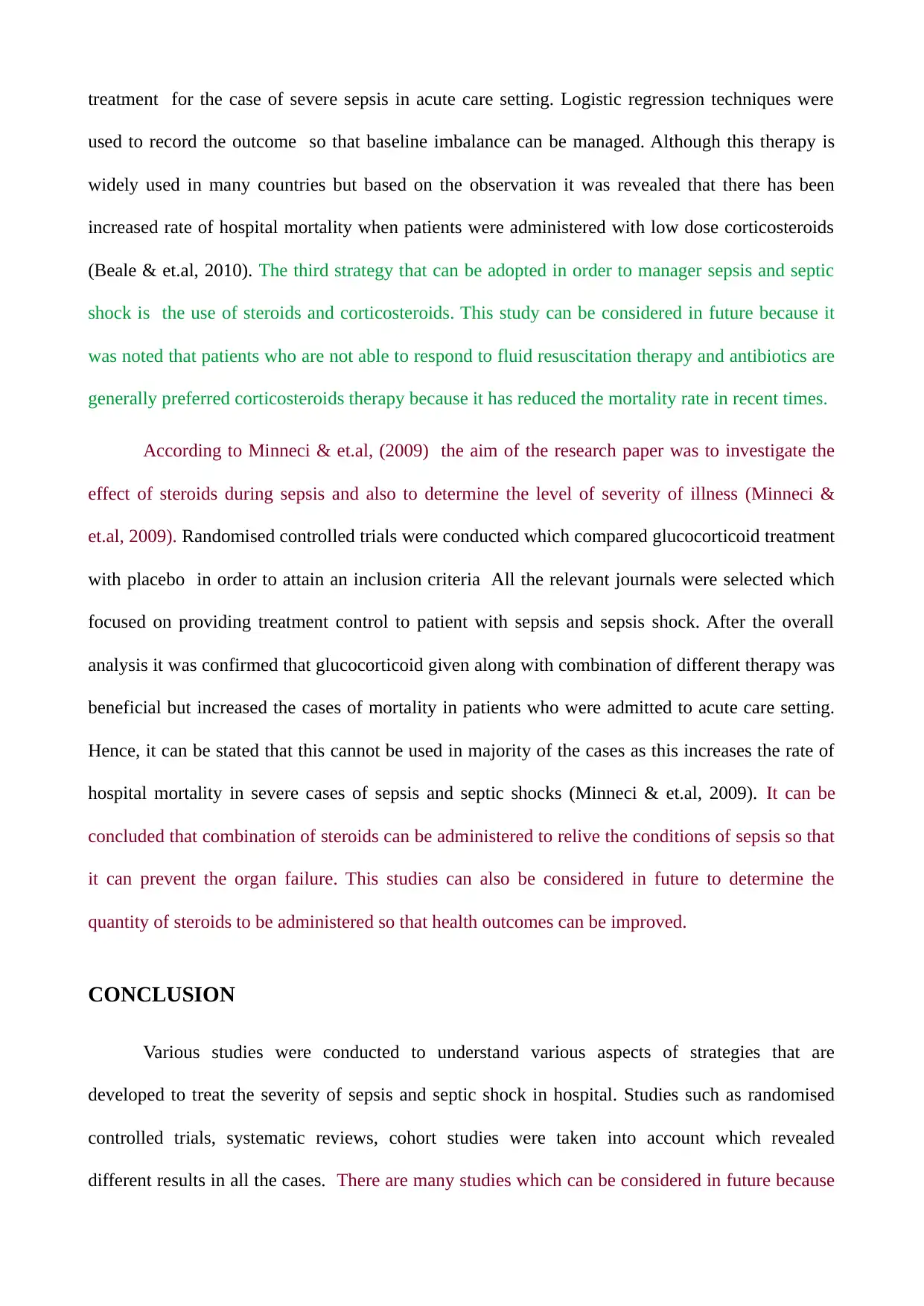
treatment for the case of severe sepsis in acute care setting. Logistic regression techniques were
used to record the outcome so that baseline imbalance can be managed. Although this therapy is
widely used in many countries but based on the observation it was revealed that there has been
increased rate of hospital mortality when patients were administered with low dose corticosteroids
(Beale & et.al, 2010). The third strategy that can be adopted in order to manager sepsis and septic
shock is the use of steroids and corticosteroids. This study can be considered in future because it
was noted that patients who are not able to respond to fluid resuscitation therapy and antibiotics are
generally preferred corticosteroids therapy because it has reduced the mortality rate in recent times.
According to Minneci & et.al, (2009) the aim of the research paper was to investigate the
effect of steroids during sepsis and also to determine the level of severity of illness (Minneci &
et.al, 2009). Randomised controlled trials were conducted which compared glucocorticoid treatment
with placebo in order to attain an inclusion criteria All the relevant journals were selected which
focused on providing treatment control to patient with sepsis and sepsis shock. After the overall
analysis it was confirmed that glucocorticoid given along with combination of different therapy was
beneficial but increased the cases of mortality in patients who were admitted to acute care setting.
Hence, it can be stated that this cannot be used in majority of the cases as this increases the rate of
hospital mortality in severe cases of sepsis and septic shocks (Minneci & et.al, 2009). It can be
concluded that combination of steroids can be administered to relive the conditions of sepsis so that
it can prevent the organ failure. This studies can also be considered in future to determine the
quantity of steroids to be administered so that health outcomes can be improved.
CONCLUSION
Various studies were conducted to understand various aspects of strategies that are
developed to treat the severity of sepsis and septic shock in hospital. Studies such as randomised
controlled trials, systematic reviews, cohort studies were taken into account which revealed
different results in all the cases. There are many studies which can be considered in future because
used to record the outcome so that baseline imbalance can be managed. Although this therapy is
widely used in many countries but based on the observation it was revealed that there has been
increased rate of hospital mortality when patients were administered with low dose corticosteroids
(Beale & et.al, 2010). The third strategy that can be adopted in order to manager sepsis and septic
shock is the use of steroids and corticosteroids. This study can be considered in future because it
was noted that patients who are not able to respond to fluid resuscitation therapy and antibiotics are
generally preferred corticosteroids therapy because it has reduced the mortality rate in recent times.
According to Minneci & et.al, (2009) the aim of the research paper was to investigate the
effect of steroids during sepsis and also to determine the level of severity of illness (Minneci &
et.al, 2009). Randomised controlled trials were conducted which compared glucocorticoid treatment
with placebo in order to attain an inclusion criteria All the relevant journals were selected which
focused on providing treatment control to patient with sepsis and sepsis shock. After the overall
analysis it was confirmed that glucocorticoid given along with combination of different therapy was
beneficial but increased the cases of mortality in patients who were admitted to acute care setting.
Hence, it can be stated that this cannot be used in majority of the cases as this increases the rate of
hospital mortality in severe cases of sepsis and septic shocks (Minneci & et.al, 2009). It can be
concluded that combination of steroids can be administered to relive the conditions of sepsis so that
it can prevent the organ failure. This studies can also be considered in future to determine the
quantity of steroids to be administered so that health outcomes can be improved.
CONCLUSION
Various studies were conducted to understand various aspects of strategies that are
developed to treat the severity of sepsis and septic shock in hospital. Studies such as randomised
controlled trials, systematic reviews, cohort studies were taken into account which revealed
different results in all the cases. There are many studies which can be considered in future because

they are able to reduce the symptoms and severity of sepsis and sepsis shock in all the patients who
are undergoing this medical condition. But on contrary to this there are many studies that cannot be
considered for future reference because if those strategies are adopted than this can lead to increase
in mortality rate in sepsis patient. It is also necessary to conduct various studies on sepsis and
various strategies that are used to manage septic shock. This will be helpful in determining the
dosing regimen and quantity of the dose to be taken so that healthy outcomes are produced.
are undergoing this medical condition. But on contrary to this there are many studies that cannot be
considered for future reference because if those strategies are adopted than this can lead to increase
in mortality rate in sepsis patient. It is also necessary to conduct various studies on sepsis and
various strategies that are used to manage septic shock. This will be helpful in determining the
dosing regimen and quantity of the dose to be taken so that healthy outcomes are produced.
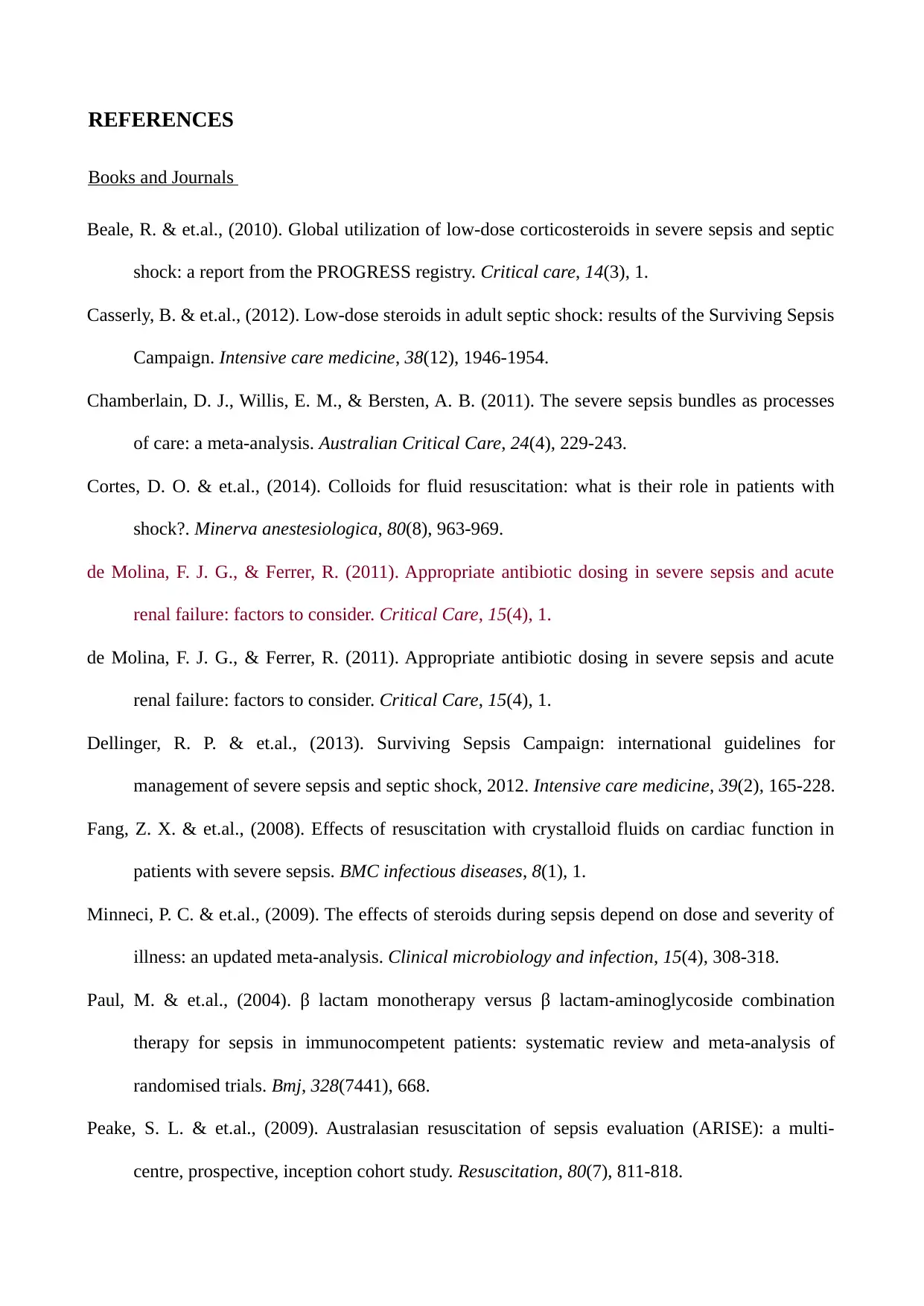
REFERENCES
Books and Journals
Beale, R. & et.al., (2010). Global utilization of low-dose corticosteroids in severe sepsis and septic
shock: a report from the PROGRESS registry. Critical care, 14(3), 1.
Casserly, B. & et.al., (2012). Low-dose steroids in adult septic shock: results of the Surviving Sepsis
Campaign. Intensive care medicine, 38(12), 1946-1954.
Chamberlain, D. J., Willis, E. M., & Bersten, A. B. (2011). The severe sepsis bundles as processes
of care: a meta-analysis. Australian Critical Care, 24(4), 229-243.
Cortes, D. O. & et.al., (2014). Colloids for fluid resuscitation: what is their role in patients with
shock?. Minerva anestesiologica, 80(8), 963-969.
de Molina, F. J. G., & Ferrer, R. (2011). Appropriate antibiotic dosing in severe sepsis and acute
renal failure: factors to consider. Critical Care, 15(4), 1.
de Molina, F. J. G., & Ferrer, R. (2011). Appropriate antibiotic dosing in severe sepsis and acute
renal failure: factors to consider. Critical Care, 15(4), 1.
Dellinger, R. P. & et.al., (2013). Surviving Sepsis Campaign: international guidelines for
management of severe sepsis and septic shock, 2012. Intensive care medicine, 39(2), 165-228.
Fang, Z. X. & et.al., (2008). Effects of resuscitation with crystalloid fluids on cardiac function in
patients with severe sepsis. BMC infectious diseases, 8(1), 1.
Minneci, P. C. & et.al., (2009). The effects of steroids during sepsis depend on dose and severity of
illness: an updated meta‐analysis. Clinical microbiology and infection, 15(4), 308-318.
Paul, M. & et.al., (2004). β lactam monotherapy versus β lactam-aminoglycoside combination
therapy for sepsis in immunocompetent patients: systematic review and meta-analysis of
randomised trials. Bmj, 328(7441), 668.
Peake, S. L. & et.al., (2009). Australasian resuscitation of sepsis evaluation (ARISE): a multi-
centre, prospective, inception cohort study. Resuscitation, 80(7), 811-818.
Books and Journals
Beale, R. & et.al., (2010). Global utilization of low-dose corticosteroids in severe sepsis and septic
shock: a report from the PROGRESS registry. Critical care, 14(3), 1.
Casserly, B. & et.al., (2012). Low-dose steroids in adult septic shock: results of the Surviving Sepsis
Campaign. Intensive care medicine, 38(12), 1946-1954.
Chamberlain, D. J., Willis, E. M., & Bersten, A. B. (2011). The severe sepsis bundles as processes
of care: a meta-analysis. Australian Critical Care, 24(4), 229-243.
Cortes, D. O. & et.al., (2014). Colloids for fluid resuscitation: what is their role in patients with
shock?. Minerva anestesiologica, 80(8), 963-969.
de Molina, F. J. G., & Ferrer, R. (2011). Appropriate antibiotic dosing in severe sepsis and acute
renal failure: factors to consider. Critical Care, 15(4), 1.
de Molina, F. J. G., & Ferrer, R. (2011). Appropriate antibiotic dosing in severe sepsis and acute
renal failure: factors to consider. Critical Care, 15(4), 1.
Dellinger, R. P. & et.al., (2013). Surviving Sepsis Campaign: international guidelines for
management of severe sepsis and septic shock, 2012. Intensive care medicine, 39(2), 165-228.
Fang, Z. X. & et.al., (2008). Effects of resuscitation with crystalloid fluids on cardiac function in
patients with severe sepsis. BMC infectious diseases, 8(1), 1.
Minneci, P. C. & et.al., (2009). The effects of steroids during sepsis depend on dose and severity of
illness: an updated meta‐analysis. Clinical microbiology and infection, 15(4), 308-318.
Paul, M. & et.al., (2004). β lactam monotherapy versus β lactam-aminoglycoside combination
therapy for sepsis in immunocompetent patients: systematic review and meta-analysis of
randomised trials. Bmj, 328(7441), 668.
Peake, S. L. & et.al., (2009). Australasian resuscitation of sepsis evaluation (ARISE): a multi-
centre, prospective, inception cohort study. Resuscitation, 80(7), 811-818.
Secure Best Marks with AI Grader
Need help grading? Try our AI Grader for instant feedback on your assignments.
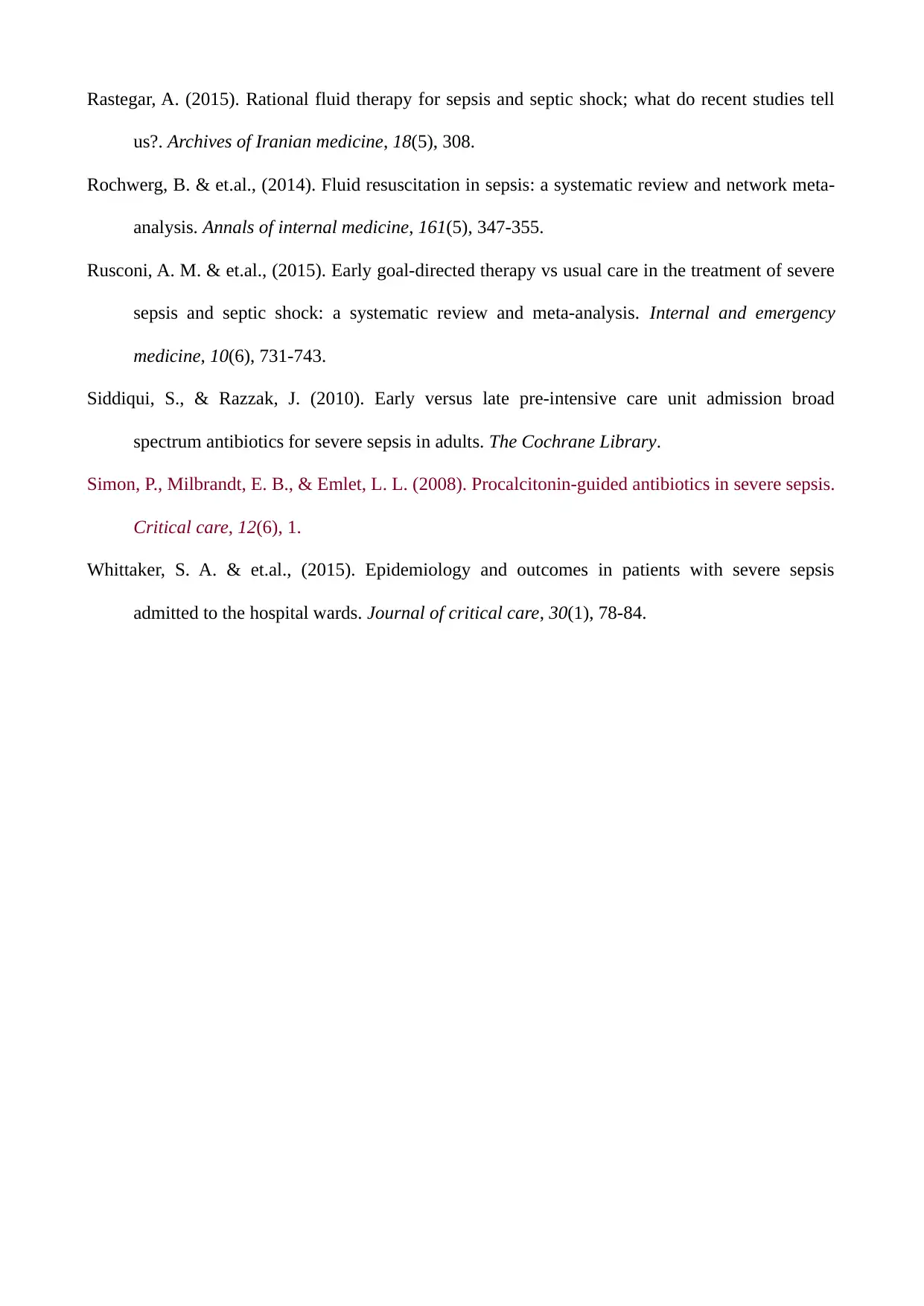
Rastegar, A. (2015). Rational fluid therapy for sepsis and septic shock; what do recent studies tell
us?. Archives of Iranian medicine, 18(5), 308.
Rochwerg, B. & et.al., (2014). Fluid resuscitation in sepsis: a systematic review and network meta-
analysis. Annals of internal medicine, 161(5), 347-355.
Rusconi, A. M. & et.al., (2015). Early goal-directed therapy vs usual care in the treatment of severe
sepsis and septic shock: a systematic review and meta-analysis. Internal and emergency
medicine, 10(6), 731-743.
Siddiqui, S., & Razzak, J. (2010). Early versus late pre‐intensive care unit admission broad
spectrum antibiotics for severe sepsis in adults. The Cochrane Library.
Simon, P., Milbrandt, E. B., & Emlet, L. L. (2008). Procalcitonin-guided antibiotics in severe sepsis.
Critical care, 12(6), 1.
Whittaker, S. A. & et.al., (2015). Epidemiology and outcomes in patients with severe sepsis
admitted to the hospital wards. Journal of critical care, 30(1), 78-84.
us?. Archives of Iranian medicine, 18(5), 308.
Rochwerg, B. & et.al., (2014). Fluid resuscitation in sepsis: a systematic review and network meta-
analysis. Annals of internal medicine, 161(5), 347-355.
Rusconi, A. M. & et.al., (2015). Early goal-directed therapy vs usual care in the treatment of severe
sepsis and septic shock: a systematic review and meta-analysis. Internal and emergency
medicine, 10(6), 731-743.
Siddiqui, S., & Razzak, J. (2010). Early versus late pre‐intensive care unit admission broad
spectrum antibiotics for severe sepsis in adults. The Cochrane Library.
Simon, P., Milbrandt, E. B., & Emlet, L. L. (2008). Procalcitonin-guided antibiotics in severe sepsis.
Critical care, 12(6), 1.
Whittaker, S. A. & et.al., (2015). Epidemiology and outcomes in patients with severe sepsis
admitted to the hospital wards. Journal of critical care, 30(1), 78-84.
1 out of 11
Related Documents
Your All-in-One AI-Powered Toolkit for Academic Success.
+13062052269
info@desklib.com
Available 24*7 on WhatsApp / Email
![[object Object]](/_next/static/media/star-bottom.7253800d.svg)
Unlock your academic potential
© 2024 | Zucol Services PVT LTD | All rights reserved.





